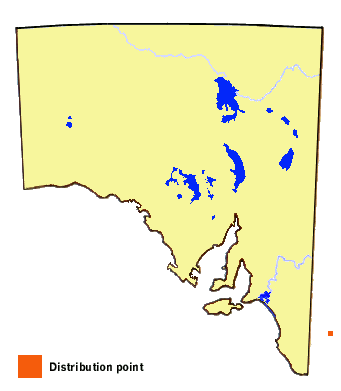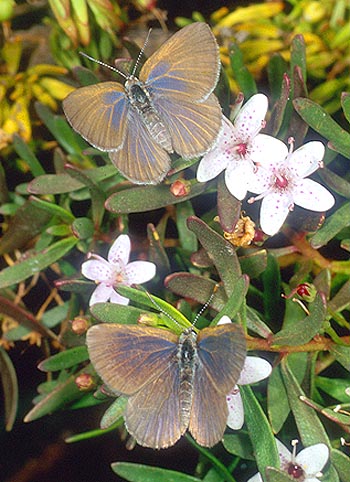-
Larval Food Host
-
Known to only utilise Myoporum parvifolium (Creeping Boobialla) (Myoporaceae).
The larvae eat the flower buds, flowers and softer green parts of the foodplants.
This plant is prostrate growing and occurs naturally in wetland and spring seepage
areas. The females will only lay eggs on plants growing in full sun.
-
Larval Attendant Ant
-
The larvae have not been reported to be attended by ants, but may occcur
in association with small Iridomyrmex ants.
-
Eggs
-
Small, initially pale green, later turning white, hemispherical, top rounded,
base flattened, with a coarsely reticulated, raised pattern which is continuous
to the micropylar area. The reticulations are irregular, consisting of shapes
varying from quadrangular to octagonal, the reticulation intersection being
sometimes very slightly raised. Laid singly on the foodplant, usually on the
calyx of flower buds and flowers, but also on the undersides of young leaves.
The eggs hatch in about 6 days during early summer.
-
Larvae
-
The final instar is about 14 mm long, green coloured with darker oblique
dorsal markings and a yellow lateral line. Larvae remain exposed on the host plant.
The larva period is about 3-4 weeks in early summer, and requires 5 instars.
-
Pupae
-
Have a shape typical for the Candalides tribe, about 10 mm long, roughly
triangular in cross-section, and having a weak abdominal saw-tooth dorsal ridge.
A divided blunt dorsal projection occurs on the thorax. The lateral part of the
abdomen and anterior edge of the head is flattened, with the head flange either
rounded or indistinctly divided at the front. Patterned in various shades of brown.
Strongly attached by the cremaster and a central girdle to the silked substrate.
Pupation occurs in dead organic litter within or around the base of the host plant
and occasionally on the undersides of the stems of the host plant.
The pupa period is usually 10-12 months, but can be as short as 2 weeks. Pupae
formed after or at the end of summer usually become dormant until the following
spring and early summer.
-
Flight Period in South Australia
-
There is one continuous flight from late August to March. The main flight is
during spring that generally corresponds to the flowering and new growth spurts
of the host plant, but a second brood can be completed in 6-7 weeks producing
a lesser flight during late summer. Abnormal late summer rains can produce
another vegetation spurt and a further short flight can occur during March
from pupae produced during the previous generation. It overwinters as pupae.

-
Distribution
-
Presently only known from two small sites 3 km apart
in the Wimmera Region of western Victoria.

-
Habitat
-
Within its known range, it is associated with its host plant where it
grows in a 25 m wide strip adjacent to saline lakes in a temperate
woodland area receiving annual rainfall of about 500 mm. The sites
have been subject to periodic short term flooding that apparently
have had no effect on the aestivating pupae.
-
Conservation Status in South Australia
-
Endangered. Only known from two small sites covering about 3 ha. Searches
for additional colonies in similar nearby habitat have been unsuccessful.
-
Threats
-
Most of the lake systems and their adjacent grassland verges occurring
in temperate farming areas were irreparably degraded very early in the
days of European settlement. Clearing, bushfires, drought, and stock
overgrazing and trampling would have made short work of this habitat.
The adjacent areas are also prime areas for cereal growing and
therefore potentially subject to aerial spray drift from poisonous
sprays. Weeds and regenerating growth of the common wetland tree
Melaleuca halmatuorum (South Australian Swamp Paper-bark) has
the potential to choke the lakeside habitat, covering the host plant
with dense shade and ultimately causing a permanent demise of the
butterfly. (M. halmaturorum and M. parvifolium would
have originally occurred together, but obviously in a situation
conducive for the survival of the butterfly. Such conditions have
now been permanently changed.) However some trees or high bushes may
be necessary for utilisation by larvae to pupate as additional
protection from the rises in the water level of the lakes during the
infrequent wet years. Rabbits and other burrowing animals are known to
damage the host plants in the breeding areas.
-
Conservation Strategy
-
The known sites are presently both protected as conservation reserves.
Additional land has been purchased in attempt to enlarge the potential
breeding habitat and provide buffer zones. The habitat obviously needs
to be cared for such that the above threats are reduced or eliminated.
New sites may have to be located and an attempt made to translocate the
butterfly so as to further reduce the possibility of extinction.
-
Acknowledgement
-
Information for this butterfly was provided from the original text of
Braby and Douglas, 2004.


